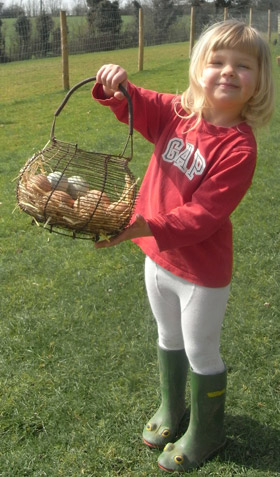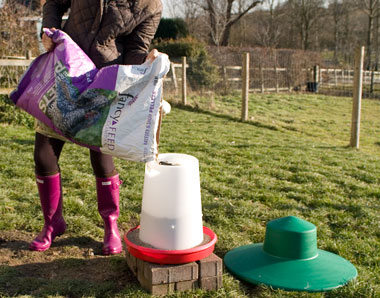There are over 200 recognised breeds of chicken around the World but not all hens are equal in their laying ability so if you would like chickens for eggs, look at my top 10 laying hens below first. It is commonly accepted that all chickens decended from the Jungle Fowl. Pure breeds of chicken have been developed over many hundreds, even thousands of years from the Jungle Fowl (although science is still challenged by the Auraucana that lays blue eggs).
A Little History of Laying Hens
 Before the First World War, ducks were the better egg layers and chicken breeds that layed 100 eggs or more per year were considered good layers. Most of the development of pure bred laying hens came after the Second World War when there were many laying trials and tests and it was common for breeders to ‘trap nest’ hens to record their individual output so that they could be used to produce further generations of laying hens.
Before the First World War, ducks were the better egg layers and chicken breeds that layed 100 eggs or more per year were considered good layers. Most of the development of pure bred laying hens came after the Second World War when there were many laying trials and tests and it was common for breeders to ‘trap nest’ hens to record their individual output so that they could be used to produce further generations of laying hens.
Development of the ‘Hybrid’
The developments with pure breeds were soon to be followed by hybrid (a cross of pure breeds) laying hens. There were millions of pounds spent during the 1950’s on creating hybrids that were not only capable of laying more eggs but also had a good feed conversion.
During this development, the parent flocks that created these hybrid layers were becoming a different ‘strain’ of their own because hens were selected for egg production rather than the way they looked.
Interestingly, duck eggs could have been on our breakfast table rather than chickens eggs… but they did not do well kept in confined conditions like chickens.
 My Top 10 Chickens for Eggs
My Top 10 Chickens for Eggs
The following table lists my top 10 laying hens (a mixture of hybrids and pure breeds) and gives an estimate of the number of eggs they are capable of producing if kept in the right conditions.
Note that there are many different strains of hens from different breeders that will perform differently… egg numbers can vary on a number of other factors too, particularly with feeding and daylight levels.
Exhibition strains that have been closely bred are not usually selected for their egg laying performance. Try to purchase hens from a good ‘Utility Strain’. There are some breeders that advertise utility strains and the number of eggs they expect from their strain every year.
Hybrids are much more reliable at producing a given number of eggs and are bred mainly for this purpose.
1. Goldline (Hybrid)
The ultimate egg machine. This little commercial brown hen will lay up to 320 large brown eggs in her first year. They have a good feed ratio and are very similar to the birds used on farms to produce eggs for the consumer market. A very friendly bird that will be in your house if the door is left open!
2. White Leghorn (Pure Breed)
Small attractive birds with a good feed efficiency that lay up to 300 large white eggs in their first year. These are the standard commercial hen used in the U.S. for egg production (because white eggs are preferred). They can be quite flighty and can fly well so make sure they can be kept securely before you buy them or clip a wing to keep them on the ground.
3. Nera (Hybrid)
Hardy birds that are great foragers and layers of a good quality large brown egg. The Nera is a cross between a certain strains of Rhode Island Red and Barred Plymouth Rock, originating in Scotland. You can expect around 270 eggs in their first year.
4. Amber (Hybrid)
The Amber is a Rhode Island Red based hybrid that looks attractive and has very soft feathering. She is a fantastic layer of up to 300 medium eggs in her first year.
5. Speckledy (Hybrid)
The Speckledy is a flecked dark hen, a cross of a Rhode Island Red and Marans. She lays around 270 large dark brown eggs in her first year.
6. Rhode Island Red (Pure Breed)
The Rhode Island Red is a good layer of up to 220 large brown eggs in their first year. Be sure to get a utility strain though as these are a popular show bird.
7. Marans (Pure Breed)
Good layers of medium to large dark brown eggs. Copper Black Marans seem to be the best layers laying up to 200 eggs in a year. They are often good winter layers, with pullets coming into lay during January.
8. Light Sussex (Pure Breed)
Attractive birds that will reward you with up to 200 medium tinted eggs.
9. Araucana (Pure Breed)
Araucanas are very unique looking. They initially came from Chile in South America. The Araucana lays around 200 medium sized blue to bluish-green
10. Crested Cream Legbar (Pure Breed)
An attractive hen with a small crest that will lay up to 180 medium sized blue to bluish-green eggs that will add a little colour to your egg boxes.






hai.. can you describe differences between heavy and light breed of layer chicken..tq
There are categories of fowl according to the Poultry Standards of GB. Heavy fowl are birds such as Orpingtons and Wyandottes and light fowl such as Leghorn or Legbar. It basically comes down to weight.
My three hens have a lovely life free ranging in a large garden and are fed only the best layers pellets. They also get treats and health supplements. However, their eggs have rather flat yolks and watery whites which spread out in the pan like cheap supermarket eggs close to their sell-by date. Why should this be? They are good layers and give me two eggs one day and three the next.
This usually happens as hens get older but watery whites can also be thanks to a disease they have had at some point. Hybrid layers that lay many eggs will usually deteriorate first so Ex-Batts for example will have watery whites as they age more so than pure breeds.
Hi, I have had my current hens ( one Light Sussex, one Maran and one Lavender Blue) for about 3 years. They have always been good layers but now when I go to the laying boxes the eggs are broken and eaten. Could this be one of the hens? The hen house is quite secure, I don’t think it is rats. Should I separate the hens? Any advice appreciated!
Egg eating is a difficult vice to cure – make nest boxes darker (an old feed bag nailed over the top 2/3 of the entrance with a few slits so they can push their way in), add golf balls or dummy eggs to the nest and collect eggs as soon as they are laid.
If all of this doesn’t work (and it usually will if you’re really clever with collecting eggs as they are laid) then you can blow an egg and fill it with a mustard-curry-egg mixture, basically anything unpleasant that they won’t like the taste of when they break it.
Great site very infomative. just moved back from spain where i had 4 hens and a so called white leghorn male but it layed?????? I shall use this site for uk Chicken keeping. The sly fox will not get my hens………
HI I have a garden that is about half an acre. I’m considering keeping maybe 4 or 5 hens as pets and for Eggs. I intend to have a coop with a sizeable run but also to let the roam free range around the garden during the day when we are home and about. They will get more free range time than in the run. My question is, will they lay in the coop or are they likely to lay eggs all around the garden whilst roaming free?
Once they get used to their house, they should lay in the coop if it has suitable nest boxes. Some of my layers have an acre of field and still return to the house to lay.
hi,
ive decide to keep some hens down at my allotment for egg purposes only. i have a coop which 6ft x 6ft, i was wondering how many hens would i be able to keep and what type is best for all year round eggs
thanks
Hybrids are by far the best layers – e.g. Goldlines / Warrens but they give all they have in their first 2-3 years of life so can be short lived. In that space, assuming you have adequate perches and they can get out in the day, I would say 12 – 20 perhaps. Either way, you should get enough eggs from that number of hens!
thanks keeping chickens,
i decided to get 6 hens consisting of 3 warrens, 2 ambers and a daisybell.
ive started to get pellets already
the hens are becoming very friendly already!!